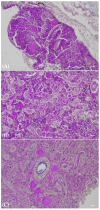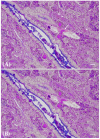Segmentation of Renal Thyroid Follicle Colloid in Common Carp: Insights into Perfluorooctanoic Acid-Induced Morphometric Alterations
- PMID: 38787148
- PMCID: PMC11126022
- DOI: 10.3390/toxics12050369
Segmentation of Renal Thyroid Follicle Colloid in Common Carp: Insights into Perfluorooctanoic Acid-Induced Morphometric Alterations
Abstract
Perfluorooctanoic acid (PFOA) is a globally prevalent contaminant of concern recognised for its persistence and detrimental effects on both wildlife and humans. While PFOA has been established as a disruptor of thyroid function, limited data exist regarding its impact on thyroid morphology. The kidney of the common carp (Cyprinus carpio) harbours numerous thyroid follicles, rendering it a valuable biomarker organ for investigating PFOA-induced thyroid alterations. Renal tissue slides, stained with the Alcian blue/PAS method, were examined from carp in three experimental groups: unexposed, exposed to 200 ng L-1, and exposed to 2 mg L-1 of PFOA over 56 days. Thyroid follicle colloids were segmented, and related morphometric parameters, including perimeter, area, and shape descriptors, were obtained. Statistical analyses revealed significant reductions in thyroid follicle colloid perimeter and area in the 200 ng L-1 PFOA group compared to the unexposed and 2 mg L-1 PFOA groups. Additionally, the fish exposed to PFOA exhibited a significantly higher follicle count compared to the unexposed fish. These findings collectively suggest that PFOA induces thyroid folliculogenesis, emphasising its impact on thyroid morphology even at an environmentally relevant concentration (200 ng L-1).
Keywords: animal model; endocrine disruptors; environmentally relevant concentration; folliculogenesis; goitrogenic effect; image analysis; kidney; one health; shape descriptor.
Conflict of interest statement
The authors declare no conflicts of interest.
Figures






Similar articles
-
Perfluorooctanoic Acid Affects Thyroid Follicles in Common Carp (Cyprinus carpio).Int J Environ Res Public Health. 2022 Jul 25;19(15):9049. doi: 10.3390/ijerph19159049. Int J Environ Res Public Health. 2022. PMID: 35897426 Free PMC article.
-
Common carp Cyprinus carpio responses to sub-chronic exposure to perfluorooctanoic acid.Environ Sci Pollut Res Int. 2016 Aug;23(15):15321-30. doi: 10.1007/s11356-016-6706-1. Epub 2016 Apr 23. Environ Sci Pollut Res Int. 2016. PMID: 27107988
-
Texture Analysis as a Discriminating Tool: Unmasking Rodlet Cell Degranulation in Response to a Contaminant of Emerging Concern.Front Biosci (Landmark Ed). 2024 Feb 22;29(2):79. doi: 10.31083/j.fbl2902079. Front Biosci (Landmark Ed). 2024. PMID: 38420806
-
Perfluorooctanoic acid (PFOA), an emerging drinking water contaminant: a critical review of recent literature.Environ Res. 2012 Jul;116:93-117. doi: 10.1016/j.envres.2012.03.007. Epub 2012 May 4. Environ Res. 2012. PMID: 22560884 Review.
-
Thyroid disruption by perfluorooctane sulfonate (PFOS) and perfluorooctanoate (PFOA).J Endocrinol Invest. 2017 Feb;40(2):105-121. doi: 10.1007/s40618-016-0572-z. Epub 2016 Nov 11. J Endocrinol Invest. 2017. PMID: 27837466 Review.
References
LinkOut - more resources
Full Text Sources
Research Materials

